Project Profiles in Manitoba
Learn more about some of the projects in Manitoba by selecting a community name:
- Angusville
- Austin
- Birds Hill Provincial Park
- Brandon
- Brookdale
- Gilbert Plains and Grandview
- Hecla-Grindstone Provincial Park
- Lorette
- Minitonas
- Moosehorn
- Morris
- Niverville
- Pelican Rapids
- Reynolds
- Shoal Lake
- Stanley
- Stonewall
- Winkler
- Winnipeg
- Winnipeg Beach
Federal Gas Tax Fund expands water infrastructure in small prairie village
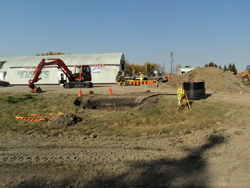
Project location: Angusville
Located in western Manitoba's Rural Municipality of Silver Creek near the Saskatchewan border, the Village of Angusville is one of the province's earliest settlements.
This longstanding, though small, community of 125 people has just taken a big step towards future growth by expanding its water and wastewater infrastructure.
Made possible by financial support from the federal Gas Tax Fund, the project involved expanding the existing clean-water and waste-water removal system to accommodate three new commercial lots and seven new residential lots in the community. The new water and sewer lines have also provided access to municipal drinking water and sewage services to additional residents living on the edge of town, who had been on private well and septic systems.
Infrastructure investments such as these help generate economic growth and job creation in small communities. Fred W. Dunn, Reeve of Silver Creek, recognized this important improvement, noting that, "By expanding the water and sewer connections in Angusville, the Rural Municipality of Silver Creek is making way for positive development in the region."
Expanding the basic services that many communities across the country take for granted represents a substantial achievement for such a small village. With essential new underpinnings now in place, residents are ready to welcome new faces to their historic hometown.
Community hall facelift and expansion
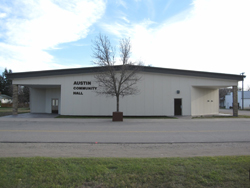
Project location: Austin
Like many small towns, Austin, faced challenges insecuring financial support for infrastructure projects, including anyrenovations to the town's aging community hall.
Now, thanks to $108,217 from the Communities Component of the federal Building Canada Fund, the Austin Community Building has received a new roof, dressing rooms and a 40-seat conference room that will include ahistorical tribute to pioneers and war veterans.
Construction also includes a new hall with expanded seating capacity, better lighting and sound. The goal is to accommodate a wider variety of functions and help attract more entertainment events to the area.
Neil Christoffersen, Reeve of the Rural Municipality of North Norfolk, in which Austin is located, is delighted with the impact the hall renovation will have on his community's social and cultural life. "The improvements are expected to produce a 20 per cent increase in the facility's use by attracting more local functionsas well as new recreation and arts programming."
Federal contribution: $108,217
Pine Ridge Bicycle Trail upgrades

Project location: Birds Hill Provincial Park
Thanks to funding from the Economic Action Plan's Infrastructure Stimulus Fund, the Pine Ridge Bicycle Trail in Manitoba has been expanded from eight to 12 feet in width.
The trail is in Birds Hill Provincial Park, part of Manitoba's Interlake Region. It is extremely popular and heavily used for cycling, rollerblading, walking and jogging by local residents of all ages.
This 7.2-kilometre paved trail winds through parkland and along Kingfisher Lake, providing users with opportunities for both recreation and outdoor fitness. The upgraded trail means a safer, smoother environment for all users, especially families biking with child carriers.
Federal contribution: $350,000
Brandon gets a boost to healthy living

Project location: Brandon
Residents of Brandon now have access to an expanded array of fitness opportunities.
Thanks to an investment from the Major Infrastructure Component of the Building Canada Fund, Brandon University (BU) renovated and expanded its athletic centre. The new Healthy Living Centre more than doubled the size of the original facility, making room for three full-size gymnasiums, seating for more than a thousand spectators, multi-purpose rooms, new athletic equipment and a four-lane jogging track. The project included upgrades to change rooms and washrooms, and the addition of a new classroom and parking space. Rounding out the amenities is a new sports medicine clinic.
The Healthy Living Centre was built to a silver level of the Leadership in Energy and Environmental Design standard, making it one of the most environmentally sustainable and energy-efficient buildings in Brandon.
The completion of the Healthy Living Centre revolutionized the university's programming potential, helping support overall student recruitment and retention. The facility provides a welcome new home for the Brandon Bobcats' volleyball and basketball teams. It also allows one of the university's premier youth programs, "Mini U," to enhance its summer programming and accept more participants.
In addition to the university's students and staff, the entire community is benefiting from the project through a wide variety of programs designed to meet residents' needs and encourage lifelong participation in active, healthy living.
Federal contribution: $5,310,000
Improving cultural infrastructure

Project location: Brandon
The Western Manitoba Centennial Auditorium in Brandon is one of the city's main cultural venues featuring theatre performances, concerts, trade shows, conventions and more.
With funding from the federal government's Infrastructure Stimulus Fund and the provincial government, this important facility received several improvements. The theatre now sports upgraded lighting and related electrical systems. It also has a new entry podium, improving access to the building and modernizing its overall appearance.
Thanks to these improvements, the City of Brandon is in a better position to promote the region's great variety of arts and entertainment and attract more audiences.
Federal contribution: $250,000
Supporting Canada's smaller communities
Ensuring water quality

Project location: Brookdale
With $354,611 from the federal Infrastructure Stimulus Fund, Brookdale, near Brandon in the southwest corner of the province, has taken steps to ensure the safety of its potable water supply and upgrade sewage collection in the municipality of 38 households.
Before work began on the new sewage collection system, Brookdale households maintained private septic systems, but drew their drinking water from shallow wells nearby. The potential existed for contamination from both the aging septic systems in the village and improperly handled ground water runoff.
Brad Wells, Reeve of North Cypress, the municipality that encompasses Brookdale, pointed to the importance of programs like the Infrastructure Stimulus Fund, for the continued existence of smaller communities across Canada. The funding allows "the town to grow, benefiting our municipality and local rural development."
Reeve Wells went on to say that "without this funding, the project would not have been possible."
Federal contribution: $354,611
Clean, safe water
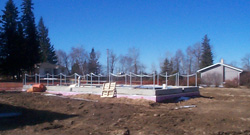
Project location: Gilbert Plains and Grandview
Two rural municipalities bordering on Riding Mountain National Park in the parkland area of western Manitoba can now boast about the quality and quantity of drinking water in their communities.
Mayor Ernie Gurica of Grandview calls it the best water quality in the province; Mayor Lyle Smith of nearby Gilbert Plains speaks of now having a safe water reserve.
Thanks to $723,333 from the federal Infrastructure Stimulus Fund, the two municipalities were able to upgrade the area's water treatment and storage capacity.
The project involved expanding water reservoirs and converting treatment facilities into upgraded pumping stations. Leaking water mains were replaced, power generators put in place in case of an emergency and steps taken to protect the two communities in case of a drought.
The changes mean the area now has the safest drinking waterpossible and supplies meet current and projected 20-year demand requirements. Firefighting capabilities have also been greatly improved resulting in a renewed level of confidence in the safety of the two communities.
Federal contribution: $723,333
Expanding wastewater treatment, and protecting wetlands

Project location: Hecla-Grindstone Provincial Park
The wildlife along the western shore of Lake Winnipeg in Hecla-Grindstone Provincial Park share environmentally sensitive wetlands with about 450 cottagers and other park users. The local cottage community is expected to grow, and so must the water treatment services.
That's why the province and the Grindstone Cottage Association applied for $700,000 from the federal Infrastructure Stimulus Fund to expand the existing sewage lagoon. This expansion was necessary to ensure that wastewater returning to the surrounding wetlands and Lake Winnipeg meets environmental protection standards. The expanded lagoon also helps keep phosphate levels low.
Lynda Grayson, a member of one of the committees that helped make the project a reality, spoke of the importance of educating cottagers about the benefits of protecting Lake Winnipeg: "Current studies show that managed wetlands benefit the lake, wildlife and the enjoyment of the outdoors by all people. We hope Grindstone will be a shining example of this."
Federal contribution: $700,000
New, safe water supply

Project location: Lorette
Lorette is one of Manitoba's many rural francophone communities. Situated just southeast of Winnipeg, it's well known to curling fans and those wanting to experience the warm and friendly welcome of local residents during the annual winter carnival.
Served by three municipal wells and hundreds of private wells, Lorette residents had put up with recurring boil-water orders after the annual spring flooding and heavy rains. The community needed a permanent solution.
With the help of $600,000 from the Communities Component of the Building Canada Fund, Lorette no longer faces these issues.
The federal funding helped drill a new water supply well and construct a one million-litre concrete reservoir and pumping station with filtration and disinfection capacity. With the new well and reservoir complete, existing municipal wells and private wells have been decommissioned.
Federal contribution: $600,000
Supporting local economy

Project location: Minitonas
Located in central Manitoba near the Saskatchewan border, the Swan River Basin includes many smaller rivers and streams that enrich the rolling prairies and grasslands. The area supports a strong agricultural base and logging in the nearby Duck Mountain region.
Near one small community in the Swan River Basin — Minitonas — two bridges over Swan River tributaries (the Roaring River and Woody River) were in danger of being closed to traffic because of rotting support timbers. This would have forced long detours for local traffic, logging trucks, school buses and farm vehicles.
To resolve these bridge problems, the Rural Municipality of Minitonas applied to the federal Infrastructure Stimulus Fund for help with the necessary upgrades. Workers replaced the wooden pilings on the two bridges with modern steel supports, reinforced the deck structure and paved the roadsurface.
As Minitonas' Chief Administrative Officer Carolyn Gordon sees it, the work was critical to maintain services to the region. The bridges will support local residents, businesses and the area's industrial growth.
Federal contribution: $52,200
Wellman Lake Water Treatment Plant

Project location: West of Moosehorn
The Wellman Lake Water Treatment Plant is located between Wellman Lake and Glad Lake in the Duck Mountain Provincial Park. It serves the many campers who flock to the popular area each year for its excellent swimming, hiking, and boating opportunities.
The plant had, however, reached the end of its life expectancy. This created concerns about the safety of the drinking water and the plant's ability to accommodate increasing visitors to the park.
Through the Infrastructure Stimulus Fund, the Government of Canada contributed $100,000 to upgrade the deteriorating infrastructure and address environmental and public safety concerns. The improvements also equipped the facility to handle increasing demands.
Federal contribution: $100,000
Industrial Park improvements complete in Morris
Project location: Rural Municipality of Morris
The Rural Municipality of Morris is located just 30 minutes south of Winnipeg near the United States border. This prime location has brought many businesses to this small community, including everything from grain auger manufacturers, to flooring installers and retailers, to graphic design and print companies. The work on the community's infrastructure projects is now complete.
Before receiving $124,752 from the Infrastructure Stimulus Fund, the streets of the town's industrial park were surfaced entirely in gravel. With new asphalt paving, the already expanding Rosemor Industrial Park is now better positioned to attract even more businesses. The work will also have long-term benefits in greatly reducing road maintenance costs.
Federal contribution: $124,752
Upgrading and safeguarding water supplies in Niverville
Project location: Niverville
Just 30 kilometres south of Winnipeg is a rapidly growing rural community of 3,200 people. The town of Niverville is enjoying an influx of young families looking to escape the big city but still enjoy the benefits of living near a provincial capital.
The town's water supply had become an obstacle to the community's continued growth. It lacked the capacity to meet future needs and didn't meet the province's current water quality standards.
Thanks to a federal contribution from the Infrastructure Stimulus Fund, Niverville has now completed work to address these issues. The existing water reservoir was expanded to provide an additional 1.2 million litres of storage, an abundant supply for a town of this size.
The water treatment system was also upgraded to a more modern system involving new membrane technology that filters out debris more effectively. This will help ensure that the town's water quality meets provincial standards and increased demand for years to come.
Federal contribution: $832,300
Improving driving conditions in the North

Project location: Pelican Rapids
Pelican Rapids is located on the southeast shore of Dawson Bay in northern Manitoba. The most recent 2006 census figures indicated a population of just 89 people. This small community adjoins the Shoal River Indian Reserve by a single bridge over the Shoal River.
With a contribution from the Infrastructure Stimulus Fund, the federal government split the cost of resurfacing and strengthening one of the community's main roads with the province. Previously made of gravel and constantly in need of maintenance, Provincial Road 483 is now covered by an experimental surface that promises to better withstand the harsh freezes and thaws common to the area.
Work on this project was completed on time during the spring of 2011, and is allowing area residents to enjoy a safer, smoother and more enduring road surface.
Federal contribution: $4,000,000
New bridge eliminates 30-kilometre detour

Project location: Reynolds
Advancing age and maintenance needs that were no longer cost-effective to repair forced Manitoba's transportation authorities to close the Lenchuk Creek Bridge in May 2008. The bridge had deteriorated to the point where the pilings had shifted, making the structure susceptible to collapse.
Since theclosure, farmers, loggers, residents and even emergency vehicles travelling along Birch River Road have been forced to take a 30-kilometre detour to cross the creek. This delay was not only a costly inconvenience for local residents and commercial traffic; it also meant that emergency services couldn't meet their standards for response time.
With a contribution from the federal Infrastructure Stimulus Fund, the Lenchuk Creek Bridge has now been replaced. When it was designed, the engineers were mindful throughout the process to ensure the natural habitat of a rare local minnow remained undisturbed.
The new bridge has now restored a vital emergency link and will support more efficient movement of goods and services across the region for years to come.
Federal contribution: $83,333
Conserving wetlands by managing wastewater
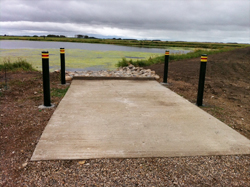
Project location: Shoal Lake
The Hamlet of Oakburn is located in the southern Manitoba wetlands surrounding Shoal Lake. It is a small community of 200 people and, like many others, often struggles to come up with the funding required for major infrastructure projects.
Until recently, Oakburn's wastewater lagoon had not received significant upgrades since it began operating more than 40 years ago. Worried that leaks could cause nearby ground and water contamination, residents had begun to raise concerns.
To improve the sustainability of Oakburn as a community and meet environmental standards, thelagoon walls were replaced. This has stopped any seepage and helped safeguard the health of residents.
This project would not have been possible without the federal Infrastructure Stimulus Fund contribution, which provided one-third of the $600,000 needed for the project.
Federal contribution: $200,000
Increasing water supplies to match community growth

Project location: Stanley
Known as the "Gardenland of Manitoba," the Rural Municipality of Stanley is a rapidly growing community located roughly 20 kilometres from the Canada–US border.
Between 2001 and 2006, the population of this farming-based municipality increased from 5,000 to 6,367, a rise of almost five percent per year. As the population grows, so does water usage. To keep pace with increasing demand, Stanley needed extensive upgrades to its water infrastructure.
With help from the Infrastructure Stimulus Fund, work to enlarge each of the area's three water reservoirs is now completed. The project also entailed the installation of new water lines and a booster station to sustain water pressure in times of high demand.
These improvements help ensure Stanley's water infrastructure can handle growing residential and farming needs today and well into the future.
Federal contribution: $421,667
Investing in arts and culture in rural communities

Project location: Stonewall
The Quarry Park Visitor Reception Centre was a museum dedicated to the history of Stonewall, a small limestone-mining town 30 kilometres north of Winnipeg. It was housed in a converted limestone kiln.
When the facility was destroyed by a fire in 2007, part of the town's identity was also destroyed.
The Town made it a priority to replace this key community facility and, thanks to a contribution from the federal Infrastructure Stimulus Fund, the project is now complete.
The new two-story Quarry Park Heritage Arts Centre provides all the space required to showcase the gallery's many historical artifacts. It also serves as a local visual and performing arts centre. A 250-seat theatre complements several classrooms, hospitality services and meeting spaces.
With a collection focused on limestone fossil formations and local quarry operations, the centre is expected to draw in a number of tourists and students. It has replaced a cherished local landmark and will nurture future generations by mining the past.
Federal contribution: $1,350,000
Improved rural water supply

Project location: Winkler
One goal of the Communities Component of the Building Canada Fund is to help ensure Canadians have access to clean, safe water. A project in Manitoba's Pembina Valley helped fulfill this objective through the replacement of an aging water treatment facility.
As one of the fastest-growing areas in Manitoba, the Town of Winkler has seen increased demands on its potable water supply. The previous treatment facility was at the end of its projected life-expectancy and often ran at full capacity. This means the town couldn't always meet water demands during peak summer months and sometimes had trouble with reduced water pressure for fire-fighting. This presented a serious risk to public safety.
With a contribution from the Communities Component of the Building Canada Fund, the federal government helped provide the 10,000 residents of Winkler with a new reverse-osmosis water treatment system. One of the most important benefits of this system is its ability to purify brackish water at a relatively low cost, which makes more raw water available to the town.
The new system also has a lower environmental impact as it reduces the need for a number of industrial chemicals and eliminates many unwanted residues.
Federal contribution: $1,197,000
State-of-the-art health and fitness centre coming to the University of Manitoba
Project location: Winnipeg
A new health, wellness and fitness facility is being built at the University of Manitoba to help students and Winnipeg residents stay active.
The current campus fitness centre, known as the "Gritty Grotto," is being replaced by a four-storey, open-concept building that will offer world-class amenities in a brighter, more welcoming environment.
The 3,505-square-metre facility will include a high-performance training centre for elite athletes, a state-of-the-art indoor running track, a 12-metre climbing wall, and strength and conditioning rooms. It will also house a research centre, gathering space for students, and three group workout studios.
"The construction of the Active Living Centre is a prime example of transformative change under way at the University of Manitoba,"
; said Dr. David Barnard, President and Vice-Chancellor of the University of Manitoba. "The Centre is positioned as a gateway to the Fort Garry Campus and will contribute to our commitment to sustainable, active and healthy living within the community."
Once complete, the centre will be the largest of its kind in the province and is expected to welcome more than 2,000 students and residents daily.
The governments of Canada and Manitoba are contributing to this project through the Provincial-Territorial Base Fund. The City of Winnipeg used funds from the sale of the Polo Park Stadium to support the project with the balance of the funding coming from the University of Manitoba.
Winnipeg's bus fleet gets a new home thanks to federal Gas Tax Fund
Project location: Winnipeg
The City of Winnipeg Transit Commission is now benefiting from a new bus parking and a service garage to address immediate and long-term space requirements. Located in the former Fort Rouge Rail Yards, the new facility was completed on budget and is now ready to welcome up to 153 regular 40-foot buses.
At approximately 12,500 square meters, one and a half times the size of a Canadian Football League field, the building can also accommodate longer articulated buses. It includes a servicing lane where buses returning to the garage will be cleaned and fuelled for the next day. The support areas in the building include a dispatch office where buses and operators will be assigned their daily work, a bus operator waiting area and a locker/lunch room for bus servicing staff.
The building was also built to a Silver Standard of Leadership in Energy and Environmental Design, meaning it incorporates numerous energy-efficient features.
In addition to providing the operational space necessary to accommodate future fleet expansions, the new garage is large enough to store buses from other areas of the city when other facilities need upgrading.
This project was made possible by financial support from the federal Gas Tax Fund, the Province of Manitoba and the City of Winnipeg.
Highway overhaul creates smoother, safer Trans-Canada

Project location: Winnipeg
It's one of the most heavily-used stretches of four-lane highway in the province, handling a steady stream of commercial and tourist traffic. It links Manitoba's major cities and connects Manitoba with the rest of Canada to the east and west.
Part of the Trans-Canada Highway, also known in Manitoba as Provincial Trunk Highway 1, has now received an overhaul.
With $30 million from the Infrastructure Stimulus Fund, the Province of Manitoba went to work in the summer of 2009 reconstructing about 30 kilometres of the Trans-Canada from the Perimeter Highway around Winnipeg east as far as Ste. Anne and Provincial Trunk Highway 12. One goal of the reconstruction was to prevent costly repairs associated with the annual spring thaw of the roadbed.
Motorists now enjoy a smoother ride with less wear and tear on their vehicles. Commuters into Winnipeg have a safer ride to work, and the province has greatly reduced the need for costly piecemeal repairs.
According to the Province, the reconstruction of Provincial Trunk Highway 1 created about 180 jobs.
Federal contribution: $30,000,000
Improving flood protection for the City of Winnipeg

Project location: Winnipeg
Winnipeg's Red River floodway is an artificial channel that diverts excess water from the Red River around the City of Winnipeg during severe flooding. Since its construction in 1969, it has been operated more than 25 times and prevented billions of dollars in damages.
Even so, Winnipeg faced significant flooding in 1997 (the 'Flood of the Century') due to rapid melting following a spring blizzard in the Red River Basin. The flooding that resulted from the rapid thaw was catastrophic; damages were estimated at over $800 million, with the evacuation of over 25,000 people from dozens of communities.
To reduce the potential impacts of similar or larger floods in the future, the Manitoba Floodway Authority undertook a major project to increase the system's capacity. As well as expanding the artificial channel, work includes improving the inlet and outlet structures to accommodate increased water flow. Several highway, rail and utility crossings are also being reconfigured due to the increased channel width.
With much of this work already complete, the channel can now divert 4,000 cubic metres per second—more than double its original capacity. This means better protection for thousands of residents, homes and businesses, not to mention savings for the provincial economy in the event of extreme flooding.
The Government of Canada and the Province of Manitoba are equally sharing the estimated costs of the project, with the Province of Manitoba covering any additional costs that might occur over the original estimates foreach of the three phases of the project. The federal contributions have been provided through the Canadian Strategic Infrastructure Fund.
Federal contribution: $332,500,000
Maintaining an architectural icon
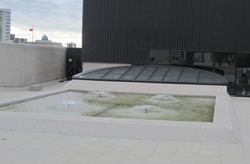
Project location: Winnipeg
The Winnipeg Art Gallery is the sixth largest of its kind in Canada. Over almost 100 years of operation, it has evolved to today's standing from a small civic gallery. The gallery's current home, officially opened in 1971, is also in one of Canada's most distinctive modern buildings. Made of Manitoba Tyndall stone, the unique triangular structure features a multi-functional rooftop space that houses a restaurant and sculpture garden, and plays host to a number of events during the summer.
With no major work done in nearly 40 years, the roof needed major repairs. Leaks during heavy weather had become chronic, which required the removal of parts of the collection.
Thanks to financial support from the federal Infrastructure Stimulus Fund, the penthouse spaces and structural roof issues have now been addressed. The restaurant's 100-foot-long window wall was replaced along with the five built-up roof areas, the skylight and the steel cladding.
The Gallery houses the largest collection of publicly owned art in the province. This project helped ensure these important works are better protected and restored the structural and design integrity of one of Canada's most significant buildings.
Federal contribution: $733,000
New construction for Winnipeg's CentrePort Canada initiative

Project location: Winnipeg
Winnipeg plays an important role in both east-west and north-south trade. It serves as a natural connecting point between Atlantic shipping lanes and the Asia Pacific Gateway. It is also the northern terminus of the fast-growing, mid-continental trade corridor, giving it the potential to take advantage of expanding trade opportunities in Canada's North.
CentrePort Canada's inland port, is centrally and strategically located in the heart of North America and includes Winnipeg's James Armstrong Richardson International Airport.
The initiative involves establishing the airport and surrounding land as a hub for importing and distributing goods from Asia and Europe throughout North America by air, rail and road. It also connects local businesses to world markets. The model includes developing a high-speed transportation corridor to help promote use of the inland port.
Part of the funding Manitoba receives from Canada under the Provincial-Territorial Base Fund is going to this initiative, estimated at $136.7 million in total. Other funding comes from the Asia Pacific Gateway and Corridor Initiative.
CentrePort Canada will help Winnipeg further expand its role as a major trading centre for decades to come.
Federal contribution: Manitoba is receiving $175 million through the Provincial-Territorial Base Fund for initiatives across the province.
Nourishing the community—considering the environment

Project location: Winnipeg
Innovation is in full bloom at Winnipeg Harvest Incorporated, a non-profit organization dedicated to collecting and sharing surplus food with underprivileged membersof the community. On average, Winnipeg Harvest provides emergency food servicesto some 58,000 people each month.
Thanks to a contribution from the federal government's Infrastructure Stimulus Fund, the organization rehabilitated some vacant industrial space to make room for a new community food share and education centre.
The newly 'greened' building is a vibrant gathering space featuring amodel urban garden and training kitchen. These facilities support food production and nutritional meal preparation programs to help people with low incomes improve their health and reduce their food bank dependancy.
The new Winnipeg Harvest Community Food Distribution & Training Centre provides the space needed to meet demands for food bank services. Winnipeg Harvest can now focus on working with the community to find long-term solutions to hunger and poverty.Federal contribution: $1,666,667
Refurbishment of world-class arts and culture venue

Project location: Winnipeg
The Manitoba Centennial Centre is an important, long-standing cultural and performing arts complex located in the heart of Winnipeg. It houses the Manitoba Museum, the Planetarium and the Manitoba Theatre Centre. It is also home to the Centennial Concert Hall, which hosts a variety of stage and sound presentations, from those by the Winnipeg Symphony Orchestra to rock concerts, comedy and dance performances.
The Centennial Centre was constructed in 1968 as part of an urban renewal program, but was showing its age and needed a variety of upgrades to restore it to its former glory.
With financial support from the federal government's Infrastructure Stimulus Fund, these improvements are now complete. As part of the restoration, workers improved performance-related infrastructure such as dimmer systems, stage lighting and control options, and performer dressing rooms.
They also built new concession facilities, improved washroom access, made structural repairs and restored the parking lot and surrounding grounds. Restoring the cenotaph and installing new marketing screens outside the complex were also part of the project.
Customers, performers and staff are enjoying new comfort and improved safety thanks to the refurbishment. The restored complex is also now well positioned to continue promoting culture in Manitoba for many more years to come.
Federal contribution: $2,500,000
Revitalizing a critical Red River crossing

Project location: Winnipeg
Since the Disraeli Bridge opened in 1960, Winnipeg's population has nearly tripled to 730,000. As the primary connection between downtown and northeastern parts of the city, more than 42,000 vehicles use this Red River crossing daily. The bridge needed to be replaced for structural reasons, but also to improve and accommodate these peak traffic flows.
In June 2009, the City's Public Works Department conducted extensive public consultations. In addition to safety and reliability, residents wanted better traffic flow, more active transportation options, and a design reflecting local culture.
As a result of these consultations, the City built a new four-lane bridge for motorists alongside the old one, which is now open to traffic. The new bridge will last about 75 years and can accommodate a potential future expansion to six lanes. A new Canadian Pacific Rail overpass on the south side of the bridge is also now complete.
The old bridge will be demolished down to its piers and used to support a new footbridge lined with public art displays, rest areas and interpretive lookouts.
This active transportation link will help reduce traffic further by encouraging people to leave their cars at home. And while they get some exercise and reduce greenhouse gas emissions, they'll have access to some of the City's cultural heritage and local artwork.
Supporting active lifestyles

Project location: Winnipeg
Hockey arenas in Winnipeg are in high demand for much of the year with minor and recreational leagues, as well as several professional teams vying for ice time.
Thanks to the federal government's Provincial-Territorial Base Fund, residents now have a brand-new recreation complex in the city's west end to help meet this demand.
The new Manitoba Telecom Services (MTS) Iceplex features four NHL-size hockey surfaces and offers more than 20,000 hours of recreational ice time per year.
With seating for more than 1,500 spectators in one of the rinks, the Iceplex has also become the official home of theWinnipeg Blues junior hockey team, and the training ground for the Manitoba Moose hockey team.
The facility features advanced telecommunications services, including Wi-Fi connectivity and improved wireless accessibility. The facility also boasts twenty dressing rooms and workout facilities, as well as concession, retail and restaurant space, making it ideal for local games and tournaments.
Federal contribution: Manitoba is receiving $175 million through the Provincial/Territorial Base Fund for initiatives across the province.
United Way of Winnipeg

Project location: Winnipeg
For the past 25 years, United Way of Winnipeg has leased the same space at 5 Donald Street, during which time its role has evolved from being one of a fund raiser to one focused on bringing people together to find solutions to Winnipeg's most pressing social problems.
This project involved the construction of a new three-storey 1,858 m2 building for United Way's Winnipeg operation in the downtown area on Main Street at the Disraeli Freeway, between Pacific and Alexander Avenue. The 2nd and 3rd floors of this new buildinghouse the agency's staff, while the main floor accommodates professional development, training and volunteer opportunities for the non-profit sector. More than bricks and mortar, the new building will enhance the United Way's work and broaden its reach and impact in the community.
United Way is committed to the community; additionally, the move to a more central location is United Way's contribution to the revitalization of Winnipeg's downtown.
"Today's UnitedWay is comprised of thousands of volunteers from every part of our community – along with committees, councils and innovative community partnerships working year round. The new location will provide us with the space needed to support all of this work, and to forge and support new partnerships and collaborations,"
Allan Fineblit, Incoming Chair, United Way's Board of Trustees said. "With the federal and provincial funding support, United Way is able to ensure that under no circumstances donations from United Way's annual campaign will be used to raise the additional local funds for the project."
Federal contribution: $3,333,333
Winnipeg's Chinese Community Centre adapts to changing needs

Project location: Winnipeg
Since opening in the early 1980s, the Winnipeg Chinese Cultural and Community Centre has offered programs and services intended to increase awareness about Chinese culture throughout Manitoba. With the passage of time, the way the organization fulfilled its mandate changed, but the building layout had not.
It was not properly outfitted to support many of the cultural activities now offered by the Centre, such as dance, martial arts and cooking classes. Several renovations were required to help the organization better meet the needs of the community.
Thanks to contributions from several community groups and all three levels of government, the renovations are now complete. The federal contribution came from the Infrastructure Stimulus Fund and covered one-third of the eligible project costs.
The multi-purpose room was expanded and features such as wall mirrors and dance barres were added. The outdated kitchen was also upgraded, and the meeting room enlarged and improved. Most importantly, the entire building received electrical and plumbing upgrades to comply with modern safety and energy conservation standards.
With these improvements, the Centre is in a better position to effectively fulfill its mission.
Federal contribution: $66,667
Creating opportunities to enjoy the outdoors
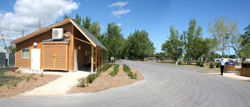
Project location: Winnipeg Beach
Winnipeg Beach Provincial Park is a highly popular, 40-hectare summer playground located on the western shores of Lake Winnipeg that is best known for its beautiful sandy beach.
July 1, 2011, marked the official grand opening of a new park facility providing 120 accessible and fully-serviced campsites. This project was completed thanks, in part, to a funding contribution from the federal government's Infrastructure Stimulus Fund.
The new campsites feature an extended boardwalk to the beach, a large children's play area, sheltered picnic space, modern washrooms, showers and a pavilion for special events. Workers also equipped the washroom facilities with green features such as solar-powered water pre-heating, energy-efficient floor heating and water conserving fixtures.
Not only has this investment provided some excellent new outdoor recreational opportunities within an hour's drive from the provincial capital, it will also promote tourism and help strengthen the local economy.
Federal contribution: $2,500,000
- Date modified: